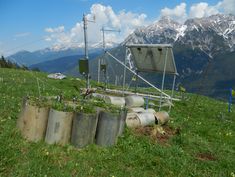Understanding the formation of nitrous oxide emissions
Nitrous oxide (N2O) is a potent greenhouse gas whose atmospheric growth rate has accelerated over the past decade, contributing to climate change and ozone destruction. Soils emit large amounts of N2O, via various abiotic and biological processes that convert nitrogen into N2O. A team of scientists, including Eugenio Diaz-Pines and Sophie Zechmeister-Boltenstern from the Institute of Soil Research at BOKU, has now been able to trace in detail the N2O production and consumption pathways that occur in the soil, and ultimately lead to the emission of this greenhouse gas. Results of this study show that dry soils may contribute as well to significant N2O fluxes.
This discovery has been possible due to the combination of two projects, the FWF-funded project “NitroTrace”, and the FFG-funded project LTER-CWN (Long Term Ecosystem Research for Carbon, Water and Nitrogen, https://www.lter-austria.at/cwn/). For the study, 16 intact grassland monoliths from the subalpine Kaserstattalm site in Stubaital (Tyrol) were exposed to extreme drought and subsequent rewetting in the botanical garden of the University of Innsbruck. These weather conditions reflect the climatic changes to which many regions across the globe, including the Alps, are increasingly exposed. “Our goal was to quantify the net effect of drought and rewetting on N2O formation processes and emissions, which is currently largely unexplored“, says Eliza Harris and Michael Bahn, from the University of Innsbruck. Contrary to expectations of the researchers, the process of nitrification -the conversion of ammonium into nitrate-, which is supposed to dominate during dry periods, did not contribute significantly to the production of N2O from the soil. The N2O production was rather dominated, also in very dry soils, by a combination of abiotic processes and denitrification -the breakdown of nitrate to N2O and molecular nitrogen (N2) by specialized microorganisms-. According to previous assumptions, denitrification takes place primarily in moist, oxygen-poor soils. Overall, N2O emission was greatest during rewetting after extreme drought, but more N2O can be released into the atmosphere during drought than expected.
Innovative analysis method
The results provide researchers with unprecedented insights into the nitrogen cycle and the processes involved in the formation of the greenhouse gas N2O in response to environmental parameters. Crucial to the research success was the use of a laser isotope spectroscope, purchased jointly by BOKU and the University of Vienna. “Through this novel analytical technique, we can determine the isotopic composition of N2O. Thus, we get a fingerprint of the processes responsible for the emitted N2O, which in turn helps us to better understand the microbial role in its turnover“, emphasizes Eliza Harris the importance of this procedure. Molecular ecology analyses also helped them determine which genes and microbes were involved in the nitrogen transformation and spatial analysis techniques helped determine elemental composition and distribution in the soil.
BOKU researchers are in charge of the operation of the state-of-the-art laser spectroscope which critically contributed to this discovery. “We can now explain why N2O emissions have been observed also during drought periods, and where they come from” explain Eugenio Diaz-Pines and Sophie Zechmeister-Boltenstern from the Institute of Soil Research at BOKU. A better understanding of production and consumption reactions can help to find solutions to reduce greenhouse gas emissions, which have been increasing for decades. “We expect to further apply this technique to better understand the effects of climate change over different ecosystem types”.
The study has been published in the journal Science Advances:
E. Harris, E. Diaz-Pines, E. Stoll, M. Schloter, S. Schulz, C. Duffner, K. Li, K. L. Moore, J. Ingrisch, D. Reinthaler, S. Zechmeister-Boltenstern, S. Glatzel, N. Brüggemann, M. Bahn, Denitrifying pathways dominate nitrous oxide emissions from managed grassland during drought and rewetting. Sci. Adv. 7, eabb7118 (2021).
https://doi.org/10.1126/sciadv.abb7118
Contact:
Dr. Eugenio Díaz-Pinés
Institute of Soil Research
University of Natural Resources and Life Sciences, Vienna (BOKU)
+43 (1) 670 2056125
eugenio.diaz-pines(at)boku.ac.at

